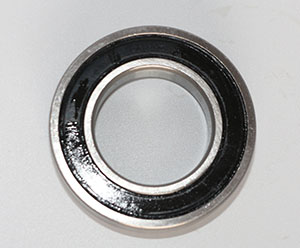
Ball bearings dimensions
Ball bearings come in various dimensions to suit different applications and requirements. The dimensions of a ball bearing typically include:
Outer Diameter (OD): This is the diameter of the outer ring of the bearing. It’s also usually represented in millimeters (mm).
Inner Diameter (ID): This is the diameter of the bore or inner ring of the bearing, where the shaft fits into. It’s often represented in millimeters (mm).
Width (or Thickness): This is the thickness of the bearing, measured from one side of the outer ring to the other. It’s typically represented in millimeters (mm).
For example, if you see a bearing described as “6204-2RS”, the “6204” refers to the bearing’s dimensions. In this case:
The “6” indicates that it’s a single-row deep groove ball bearing.
The “204” specifies the dimensions: 20mm inner diameter, 47mm outer diameter, and 14mm width.
It’s essential to consider these dimensions carefully to ensure that the bearing fits properly into your application, whether it’s a piece of machinery, automotive component, or any other system requiring rotational motion.
Additionally, bearings may have additional specifications such as load capacity, material, and precision rating that are crucial for selecting the right bearing for your needs.
Bearing Type: This specifies the specific type of ball bearing, such as deep groove, angular contact, thrust, or self-aligning. Each type has unique characteristics and is suitable for different applications.
Seals or Shields: Some ball bearings come with seals or shields to protect the internal components from contamination or to retain lubricant. These are often designated by suffixes like “RS” (rubber seal), “ZZ” (metal shields), or “2RS” (both sides sealed).
Precision Rating: Precision ball bearings are rated for their accuracy and consistency in manufacturing. Common precision ratings include ABEC (Annular Bearing Engineering Committee) and ISO (International Organization for Standardization) ratings.
Load Ratings: Ball bearings have dynamic and static load ratings, indicating the maximum load they can support under different conditions. These ratings are crucial for determining the bearing’s suitability for a given application.
Material: Ball bearings are commonly made from materials such as chrome steel, stainless steel, or ceramic. The choice of material depends on factors like corrosion resistance, temperature resistance, and load capacity.
Operating Temperature: Some ball bearings are designed to withstand high temperatures or extreme environments. It’s essential to consider the operating temperature range of the bearing when selecting one for your application.
Cage Type: Ball bearings may have different cage designs to retain the balls and maintain proper spacing. Common cage materials include steel, brass, or synthetic materials like nylon.
These specifications help ensure that you choose the right ball bearing for your specific needs, considering factors like load requirements, operating conditions, and environmental factors. Consulting with bearing manufacturers or suppliers can also provide valuable guidance in selecting the most suitable bearing for your application.
NSAR, a professional deep groove ball bearings supplier in China, provides a broad variety of deep groove ball bearing with best customer service and quality assured. With more than 20 years deep groove ball bearings manufacture experience, our deep groove ball bearing has been exported to United States, Canada, Mexico, Brazil, Argentina. you can products download,NSAR can satisfy your bulk deep groove ball bearing customization needs,We provide 6012 bearing and 6000 bearings series and 6200 bearings series and pillow block ball bearings and 6300 bearing.

